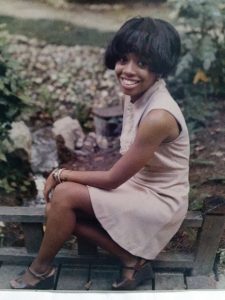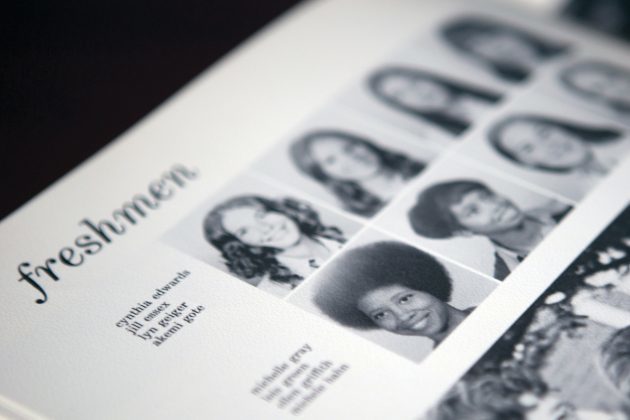Michelle Gray Haywood on ‘Being First’

Former history instructor Charles H. “Trey” Wilson reflects that, when he first taught at Brenau Women’s College in 2006, the makeup of his inaugural class represented the greatest diversity he had experienced in his academic career – 35 students: 11 African-American, two Hispanic, one from Zimbabwe, two in wheelchairs.
Things were different three decades earlier when Michelle Gray Haywood, WC ’75, Belinda Harrison Sims, WC ’75, Lois Green Harris, WC ’75, and Natalie Roberts in the fall of 1972 became the first African-Americans to enroll.
Haywood, the last surviving member of the group, recalls that being a pioneer was an interesting experience, but it was not always easy.
Originally from Detroit, Michigan, Haywood grew up in Augusta, Georgia, entered Brenau as a freshman in 1972, and graduated in three years with a degree in broadcasting and journalism.
Haywood had been a very good student in high school, active in community and church organizations. She wanted to go away to college: to Xavier in New Orleans, Spelman in Atlanta or Bennett in North Carolina. In the midst of her haggling with her mother over distance from home and expense, she was invited to a tea in her hometown for a school that was not even on her radar: Brenau. She recalls that she applied on a Friday and received her acceptance the following week. “I said, ‘Well I’m not sure about money,’ and they said, ‘Don’t worry about it. Just come.’”
Her grandmother had set aside some savings for the granddaughter’s college, but the rest she would have to fill on her own. Brenau offered financial assistance that was not available at those other schools. Still she was not convinced, Haywood recalls. “But my mom said, ‘you’re gonna do this or else.’ And, in those days, we did what our mothers told us.” Although there is some wryness in her voice, she is not joking.
She discovered some other advantages to Brenau.
“When I went into the freshman dorms at one of the black schools, and then I came to Brenau, I sort of appreciated it a little more. I was one of these people who could put myself [visually in a place] there, and I would be there.” At Brenau, she added, “things were personalized in ways that I don’t know that I would have occurred at another school. At Thanksgiving, we had a turkey and the trimmings. We had cookouts and they would bring everything from inside, outside. We would be out on Lake Lanier and cook out, stuff that I don’t know would not have happened any place else.”
There was one Brenau perk she particularly enjoyed, which she says she almost definitely would not have received at another institution: “We had maid service!” she laughs.
From College to the CIA
After graduation from Brenau, Haywood got a master’s degree at Hampton University and a job at an Augusta radio station selling advertising and hosting a jazz program. She served as a field director for the Girl Scouts. She worked in the Augusta mayor’s office and then spent a bit of time with AT&T before collecting an eye-popping entry on her resume: 18 years as a military analyst for the Central Intelligence Agency.
Although she did not – or could not – talk much about her job “with the government,” she did say that she was able to spend some time in the Middle East, including Syria, and had access to information about what was really happening in various countries that Americans no longer are allowed into.
Currently she is a supervisor with American Airlines in Charlotte, North Carolina.
“I enjoy working with people,” Haywood says about her current job. “When I worked with the government, my clients were the military and the intel (intelligence) community, so I didn’t see a lot of everyday people. We were isolated and closed up and everything was very secure, so to step away from that was very refreshing. It’s nice to see people.”
Conversationally, Haywood instantly becomes open and inviting, displaying aspects of a robust personality and a person who pulls few punches – a nice balance of genteel and brazen, the genuine Southern lady.
“When everyone says I act different, and I tell them I went to an all-women’s college, they say ‘no wonder you act the way you do,” she says. “But I was a little lady all my life, so that was just my upbringing.”
She says she gave her kids “a little leeway in terms of their college choice,” but she did try to get a niece to come to Brenau a few years ago. “She got accepted, and I thought it would be a real good legacy,” Haywood said. “They had it all set up, but she wouldn’t come.”
Time for Listening and Learning
When Haywood came to Brenau, she roomed with Lois Green, a special education major from Fort Polk, Louisiana, in Yonah Hall. “I was used to having my own room,” she says, “so when I roomed with Lois, that was the first time I had ever shared a room. But Lois was amazing. She was such a good person. She did a lot of work study, and I did some, too.” Belinda Harrison, a sociology major from Anderson, South Carolina, was a suite mate and she, along with Natalie Roberts of Jersey City, New Jersey, also majoring in sociology, became part of this unique band of sisters who broke the color barrier at Brenau.
Haywood and other African-American students matriculated at Brenau Women’s College as the South – and Brenau along with it – began making the slow, continuing transition from racial segregation. The segregationist Georgia Gov. Lester Maddox was only two years out of the governor’s mansion on Paces Ferry Road but was still the state’s lieutenant governor. During the early 1960s he had infamously passed out hickory ax handles to patrons of his fried chicken restaurant in the capital city and in 1972 still ran a souvenir kiosk in Underground Atlanta where he appeared almost daily to sell and autograph facsimile ax handles for patrons.
The sorority of the first four African-American students at Brenau quickly expanded with the addition of students like Marilyn Bell Dixon, WC ’76, Jacqueline Moorehead Drake, WC ’75, and Phyllis Hawks-Brewer, all from Gainesville and all of whom transferred in from Gainesville Junior College starting in the fall of 1973. (Dixon, who now lives in nearby Braselton, was a commuter student who earned a degree in secondary education and retired three years ago after 34 years with the Georgia Department of Human Resources for 34 years. Drake, a residential student, graduated with a degree in health and physical education. She spent 20 years in account managing. Today, she is a nonprofit training services manager in Atlanta. Hawks Brewer, from nearby Lula, Georgia, came to Brenau in the fall of 1973 and studied early childhood education through the summer of 1975.)
Although Haywood recalls generally that there were few problems in her relationships with other students, faculty and staff, she does remember some lingering undercurrents of racial insensitivity and “tone deafness” to real issues as the African-American students struggled to learn how to get their voice heard and the Caucasians struggled to learn to hear them.
For example, there was the episode of the lawn jockey in front of one of the sorority houses. Haywood does not recall which one. However she does remember that she and other African-American students would “paint him white.” The sorority women would in return “paint him black. We’d paint him white. They’d paint him black.”
Haywood also recalled going out on a limb in a class assignment and writing an essay of her perceptions of the unequal treatment that she received from some instructors, in the cafeteria and in other aspects of life on campus. Her essay got her a meeting with a top administrator, who seemed “shocked” by her perceptions, she says, but then he proposed a solution that focused solely on her complaint about her treatment in the cafeteria by asking whether putting more “soul food” on the menu might ease the problem.
“But I never had problems getting along with the young [white] ladies [on campus],” she says. “If I needed a ride to Augusta, there were two who, even though they lived in Greenville/Spartanburg and it was out of their way, would drop me off in Augusta on their way home.”
Support System
However, the support system of African-American sisters was a great help, Haywood muses. Sororities on the campus at the time still had not added African-American members. Although she says she learned later that the African-American women probably could have formed a chapter of a national sorority, all of her group remained keenly focused on surviving as students and “just graduating.”
Social activities generally were ad hoc, but there were plenty. Brenau always has marketed its comfortable, slow-paced hometown environment of Gainesville but with the distinct advantage of being close enough to a big city for students to enjoy. And Haywood, who concedes that she never really got past that initial desire to go to a school in a bigger city, took advantage.
“I would’ve lost my mind if I hadn’t [gotten off of campus each day],” she says. Her mother had graduated from Atlanta University, so Haywood says she already knew the Atlanta area. She had high school classmates and other friends at Clarke, Morris Brown, Morehouse, Georgia Tech and, in nearby Athens, the University of Georgia. “So, I was familiar with both areas, especially Atlanta…. Marilyn, Phyllis and Jackie all had cars, so we would pile in somebody’s car and go to Atlanta and hang out. I think all of us ended up dating someone from Morehouse.”
The “lasting friendships,” she says became her best experience from Brenau days. Haywood and Green roomed together in Yonah Hall and shared a suite with Sims. Through the years, the four – Haywood, Sims, Roberts and Harris – stayed in close contact. Haywood and Sims wound up living in close proximity to one another in the Augusta and Washington D.C. areas, and they became especially close. However, Sims died in 2006, Roberts in 2012 and Harris in 2015.
“If I had gone someplace else and it had been a larger school, with of us all having different majors,” she says, “I don’t know if our paths would have crossed. We all took care of each other and watched out for one another. We were all different personalities, but we had one thing in common, which was survival there.”

